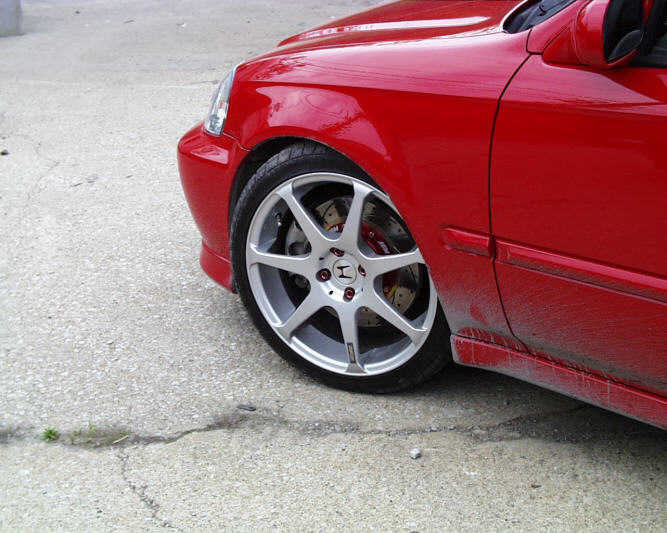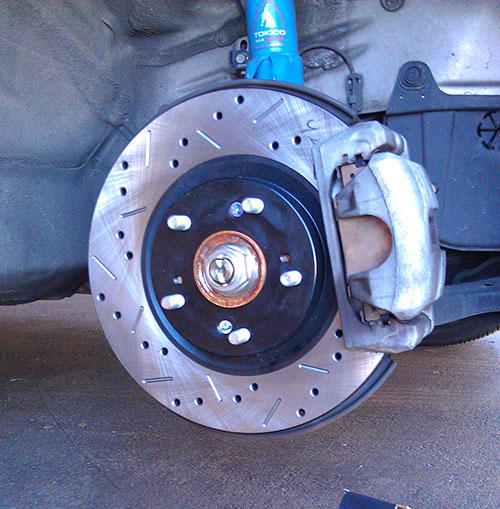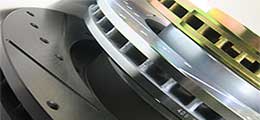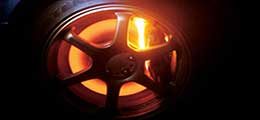*source - streetsports.com

Most people that visit cquence.net are looking to increase stopping power, but do not have an accurate idea of what it takes.
Yes, you can increase stopping power and distance with upgraded parts, but not every upgrade does what the advertiser claims.
Most amateur auto enthusiasts, when looking into brake performance for the first time, think that braking power has something to do with being able to lock up your tires. When we talk about braking power, we are talking about the amount of friction that exists between a brake pad and a rotor.
Poorly performing pads and rotors will not react to your braking commands quickly due to low friction quotients. By increasing that coefficient of friction, you will be able to decrease the time required to stop, and the distance it takes to do so.

Install Of Cquence Performance Rotors
* source - g6performance.com
There are several brake components that contribute to your stopping power.
Tires
Brake Pads
Brake Rotors (Size)
In order to maximize stopping power, it is important to address all 3 components.
A tire upgrade comes first. A general purpose tire will not perform nearly as well as a high performance tire when applying brakes firmly. A high performance tire will have more surface area touching the road, and therefore more friction applied to the road overall.
Once you have installed performance tires on your vehicle, you should then be looking at high performance ‘street’ brake pads as the next step in upgrading. Brake pads that are more aggressive than stock will have the ability to dig into the brake rotor better and increase the coefficient of friction between the rotor and pad. Note that a high performance pad will degrade more quickly than stock, and will need to be replaced more often as a result.
Once you have decided to install upgraded brake pads, then you should go one step further and upgrade your rotors at this time.
When selecting your rotors, you will have to consider several things in order to make the right decision…
What are your braking needs. If you anticipate braking aggressively over a short period of time, you should be using a larger brake rotor that has refined ability to disperse heat. A cross drilled rotor can further increase heat dissipation by increasing the surface area of the metal.
Wheel clearance. Wheel clearance is the distance from the rotor to the edge of the wheel rim. What is the maximum rotor size that can be installed on your vehicle? A larger rotor will decrease your wheel clearance, and can make installing a spare tire impossible.
Brake pad material clearing. A slotted rotor will be able to clear off brake pad dust that accumulates on the rotor. If you are using a highly aggressive pad, then you most certainly want to use a slotted rotor design.
Slotted design for additional brake pad friction. When using the slotted brake rotor design, the slot groves will allow the brake pad to dig in better during braking. When using a combination of highly aggressive brake pads with slotted rotors, you can realize a very high coefficient of friction. This combination of brake pad/rotor use will result in the highest rate of brake pad degrade.
Rotor Size. You can increase your vehicle’s stopping power and distance by increasing the size of your brake rotor. Even upgrading the size of the brake rotor by a diameter of 1” will make a difference.
When a brake rotor diameter is upgraded in size, there is more torque applied to the wheel due to a greater amount of leverage during braking. Aftermarket rotors are often bigger than stock, but not always. A commonly used upgraded rotor diameter distance is 2”. In this instance, a decrease in stopping distance can be realized in the amount of nearly 15 feet at speeds of 60 MPH. This calculation is made using a 3500 pound vehicle weight as a reference.









